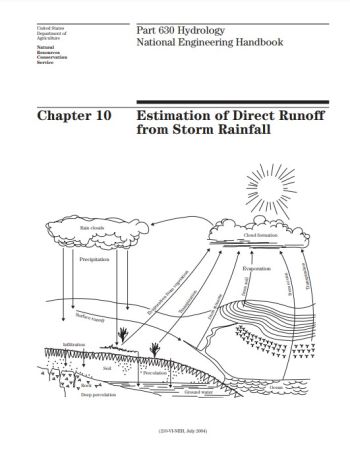National Engineering Handbook: Chapter 10 - Estimation of Direct Runoff from Storm Rainfall
Natural Resources Conservation Service, 2004

The Natural Resources Conservation Service (NRCS)method of estimating direct runoff from storm rain fall is described in this chapter. The rainfall-runoff relationship is developed, parameters in the relationship are described, and applications of the method are illustrated by examples.
The NRCS method of estimating direct runoff fromstorm rainfall was the end product of a major field investigation and the work of numerous early investigators (Mockus 1949, Sherman 1942, Andrews 1954,and Ogrosky 1956). A major catalyst for getting this procedure to the field was the passage of the Water-shed Protection and Flood Prevention Act (Public Law83-566) in August 1954. As a result, studies associated with small watershed planning requiring solutions of hydrologic problems were expected to produce aquantum jump in hydrologic computations within NRCS (Rallison 1980, Rallison and Miller 1982). Most NRCS work is with small, ungaged, agricultural water-sheds, so the method was developed for rainfall and watershed data that are available or easily obtainable.
The principal application of the method is in estimating quantities of runoff in flood hydrographs or in relation to flood peak rates (National Engineering Handbook 630 (NEH-630), chapter 16). An understanding of runoff types is necessary to apply the method properly in different climatic regions. Four types are distinguished: channel, surface, lateral subsurface flow, and baseflow.
Revision ID: 5891
Revision Date: 12/16/2022
